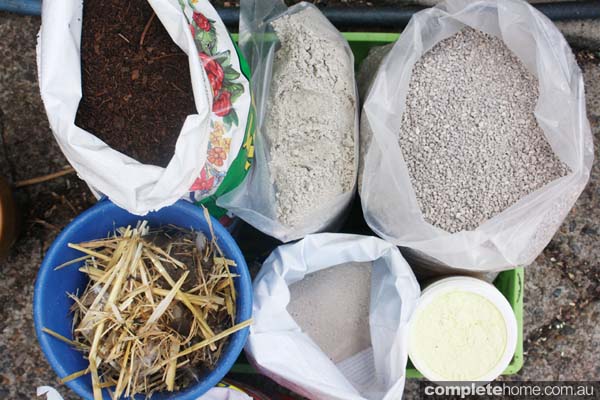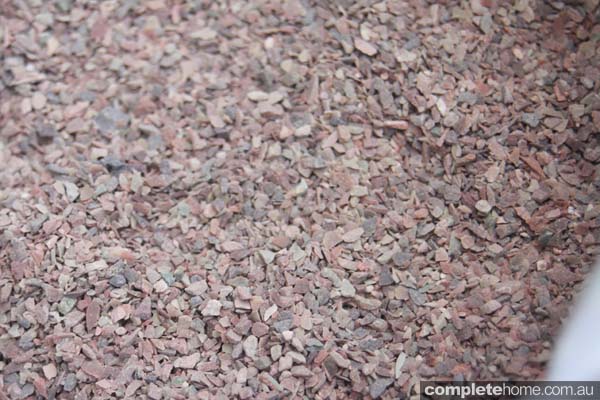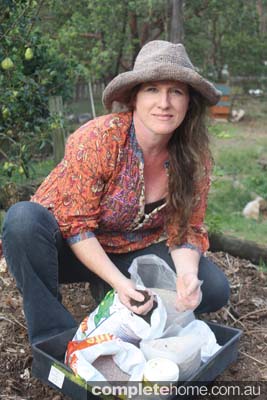Down to the nitty gritty: soil additives What they do and why you need to consider using them
If you want to create a productive organic garden, your success depends on what lies beneath your feet: the dirt!
Don’t try to guess the soil’s pH — you can’t. For accurate readings, you must have a pH testing kit, available at large hardware stores and garden centres.
Organic gardening is a bit tricky sometimes, as knowing what can and cannot be added to the soil, while remaining within organic guidelines, is often confusing. Of course, the average home gardener doesn’t have to worry to the extent of having their garden organically certified, although I do know of a few who have gone that far. It’s predominantly those who are offering products and produce on a larger scale, for the meat, fruit and vegetable market, that have to go through the rigours of certification.
I recommend looking for organic certification logos on the bag or packaging when buying any product you intend to use on the garden, especially the vegie patch. This can be either the Australian BFA or NASAA certification emblem. The logo and organic certification number will be clearly visible. And it’s worth noting that the word “organic” on packaging does not necessarily mean the product is organic. For certainty, it must have the certification logo.
If you want to create a productive organic garden, your success depends on what lies beneath your feet: the dirt!
What type of soil?
The shelves of garden centres and hardware stores across the country are groaning with bags of fertiliser and soil additives to correct soil pH, help drainage, adjust nutrient levels and increase organic levels and water-holding capacity (plus penetration). It’s all a bit confusing to the novice gardener. And there are yet more products you can add to the soil to correct or aid the results of your soil tests.
Happily, for amending soil types and soil pH (acidity or alkalinity) there’s a range of substances that are permissible in the organic garden.
pH in brief
The pH scale of 1–14 (with 7 being neutral) has a bearing on what nutrients are available and in what quantities. When the pH is around 6.0–7.0, you will find that, as long as the soil doesn’t have any nutrient deficiencies, the full range of nutrients will be available to your plants.
Once the pH drops to 5.5 and lower, certain nutrients will be unavailable to plants, and the same goes for when the pH rises to 8 and above. Most plants are happy with a near-neutral pH, but there are some that prefer either acidic or alkaline soils, which may be your reason for needing to change the pH.
Another reason may be that soil already is too high or too low on the pH scale. This may have been caused by numerous factors, from previous concreting jobs and brought-in soil (with untested pH) to excess poultry manure or mushroom compost and so forth.
Don’t try to guess the soil’s pH — you can’t. For accurate readings, you must have a pH testing kit, available at large hardware stores and garden centres. Don’t skimp here — you’ll need to take readings in all areas of your garden and you will more than likely find these readings vary greatly.
The problems and the solutions
Acid pH
To raise an acid soil’s pH, the use of dolomite, agricultural lime, mushroom compost, wood ash and poultry manure is permitted in the organic garden.
- Dolomite is calcium magnesium carbonate, which will also deliver the nutrients calcium and magnesium to plants
- Agricultural lime will also deliver calcium to plants and improve soil structure.
- Mushroom compost must be certified organic or, if not, be thoroughly composted before use.
- Wood ash is allowed only if it’s from burnt untreated and unpainted wood and generally is needed in only very small amounts. It will often deliver the nutrient potassium to plants.
Alkaline pH
To lower soil pH, use peat moss, powdered sulphur, composted pine needles and composted sawdust.
- Sulphur is applied in a powdered form.
- Pine needles need to be composted.
- Peat moss is the partially decomposed remains of plants. It forms over many millennia in marshes and swamps. The process is simple but takes an extremely long time, so it’s important to keep in mind that peat moss is not the most renewable resource and therefore relatively unsustainable.
Clay soils
Poor drainage is the problem of clay soils which are improved by the addition of gypsum, sand and organic matter.
- Gypsum is calcium sulphate and will have little to no effect on soil pH; its main purpose is to break up clay particles. It sometimes is sold under the name Claybreaker and bought in powdered or liquid form.
- Sand, being a larger particle in structure, helps by getting in between the smaller clay particles.
Sandy soils
These are too free-draining, so will benefit from the addition of bentonite, zeolite and organic matter.
- Bentonite is a very fine, clay-based particle that can be mixed with water and poured through the soil. There are two types available — sodium bentonite and calcium bentonite — and both will hold water and nutrient within the soil, but calcium bentonite is the most often used. It can also be used as a dam liner.
- Zeolite is a natural clay-based mineral. It can be used to filter water and as a stockfeed supplement and, because of its very large surface area, it will help hold nutrients and water within the soil.
- Diatomaceous earth is made from the remains of tiny single-celled algae and is very absorbent. Be sure it’s food-grade. It can be very dusty, so take care to wear gloves and a dust mask.
Hydrophobic soil
Because this type of soil is water-repellent, it needs mulching, organic matter and seaweed.
- Mulch of any type will help stop the top layers of the soil becoming water-repellent.
- Seaweed, applied as a liquid, can also prevent soils becoming hydrophobic.
Take it as it is?
All that said, sometimes it’s just as easy to work with the soil type you have. For example, if the soil is poor-draining and has high clay content, grow plant species that prefer wet feet. Better still, if it’s really poor-draining create a bog garden or pond full of edible aquatics in that location. With sandy, dry soils, choose plant species that really love such conditions.
As for varying pH, choose plant species that have a preference for either an acidic or alkaline soil and remember, if you add good amounts of organic matter it will act as a buffer, magically allowing plants to grow successfully, even in what appears to be an unfavourable pH.
Organic matter
Now, that’s a whole other article. But take note: organic matter in its various forms isn’t covered in detail in this article but can use be used in nearly every aspect of troubleshooting in your backyard. Organic matter will act as a buffer when soil pH is either too high or too low; it will help break up clay particles, which improve drainage, and it will add bulk and moisture-holding capacity to sandy soils that drain too freely.
It can also stop soil from becoming hydrophobic and, in nutrient-deficient soil devoid of soil life, it can help by delivering nutrients and holding them within the soil, thereby encouraging subterranean life.
It’s the miracle ingredient in all productive organic gardens and I will reveal all about fertiliser options, other organic matter and the types to use in our next issue. ■
Wetting additives
Rewetting agents
Rewetting products are generally made from synthetic polymers, but there are some on the market, such as Eco-hydrate, that are made from plant-based ingredients and are biodegradable. Eco-hydrate is Australian made, organically certified and can be used on vegies, potted plants, garden beds and lawns.
The main function of these is to improve water penetration and reduce evaporation from the soil and potting mixes. So, when rain or watering occurs, there is less water run-off and more uniform water penetration into the soil. Plant stress is alleviated with less watering required.
Water crystals
Water crystals, on the other hand, are made up of polymers — polyacrylamide — and turn to a jelly-like substance within soil or potting mix. The main purpose of these crystals is to hold moisture around the root-zone of plants. They can hold up to 400 times their own weight in water and this is generally released, over time, into the soil and root zone. Evidence shows that polyacrylamide can release acrylamide gradually, which is a harmful substance.
In my opinion, if you have taken the time to assess the soil type and added ample organic matter to the soil and mulched thickly, rewetting agents and water crystals are not needed. And, most importantly, they are not recommended in an organic environment.
Words by Claire Bickle
Claire Bickle is a Brisbane-based horticulturist; teacher, speaker, writer and organic practitioner. She is on facebook – www.facebook/clairebicklegardeningpages.com
Originally from Good Organic Gardening Vol.5 No.1










